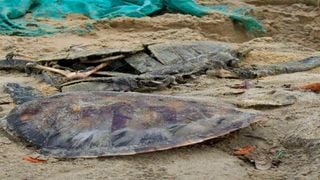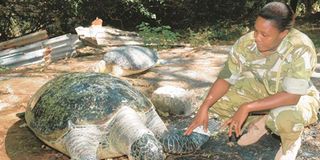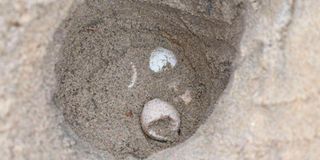
Carcasses of turtles that were found along the Marereni beach, in Kilifi County on June 9, 2021.
Mombasa
Premium
Alarm as endangered sea turtles die
The breath-taking beaches along the Indian Ocean on the Kenyan Coast have turned into a graveyard of endangered sea turtles washed up by high tides.
Several years ago, the beaches over 500km of Kenya’s coastline used to be a nesting haven for the reptiles.
But since the beginning of last year, the situation has turned around, with at least 154 endangered species reported to have died in the north and south coast of Mombasa.
The situation is dire at Marereni beach, north of Malindi in Kilifi County, and some parts of Lamu, where the incidents are reported frequently.
This is the highest number of reported deaths of sea turtles in over a decade. Poachers have pounced on the endangered marine vertebrates, for their eggs, oil, meat, skin and shells.
Turtle poaching
In 2010, there were reported cases of turtle poaching and collection of sea turtle eggs by fishermen.
On the nesting beaches, the animals, which have a lifespan of more than 50 years, have been diminishing rapidly because of sea pollution caused by plastic waste.
Marine scientists and environmental lobby groups in Kenya are shocked by the massive deaths of the turtles.
Three species of sea turtles that are almost becoming extinct in the country are the green, hawksbill, and olive ridley and environmentalists say they are dying rapidly in Marereni.
The deaths in Malindi, Kenya’s international tourist hub, have also been attributed to salt factories near the coastline that are accused of discharging poorly untreated waste into the sea, thus endangering the turtles.

A Kenya Wildlife Service officer examines dead green sea turtles in Mombasa in 2017.
According to scientists, a combination of poaching, illegal fishing, pollution and fishing trawlers that come too close to the shores in feeding sea grass areas or those that do not use turtle-excluding devices has contributed immensely to the loss of sea turtles.
“Illegal fishing is either by setting nets at these grass and corals where turtles frequently visit to feed, use of spear guns or by catches. Pollution is either through plastics or discharge of poorly treated wastewater from nearby salt manufacturing factories,” said Dr Thomas Kalama Mkare, a researcher at the Kenya Marine and Fisheries Research Institute (KMFRI).
Dr Mkare, an expert on sea turtles, warned that the discharge of untreated waste into the sea could lead to a burst of harmful algae, bacteria, parasites such as barnacles, viruses, and diseases. Cases of fibro papillomatosis (FP) disease have been reported among sea turtles in the area.
In an interview with Nation.Africa, Dr Mkare explained that some of the turtle that have died of the disease have large hanging external tumours that prevent them from swimming, having clear vision, feeding and escaping from predators.
“Cases of dead turtles being found in plastic sacks have also been observed. It is important to note that while sea turtles are dying at such an alarming rate, fish such as groupers, rays and box fish have also been dying in the same area,” he said.
KMFRI and the Kenya Fisheries Service used to deploy observers to collect data and check on compliance among trawl fishers but that work was suspended after the emergency of the Covid-19 pandemic in 2020.

Marereni Biodiversity Conservancy Community Based Organisation secretary David Kazungu Gohu removes a fishing net from the shores of Marereni in Kilifi County on June 10, 2021.
There are seven species of sea turtles around the world, with Kenya boasting of five, including the leatherback, loggerhead, green, hawksbill, and olive ridley, which have also been listed by the International Union for Conservation of Nature (IUCN) as critically endangered.
For the past eight years, Dr Mkare has been generating data that can be applied for sustainable management and conservation of marine organisms.
“The entire coastline from Kiunga in the north to Vanga in the south have three different sea turtle’s species, including the green turtle, hawksbill and olive ridley, which are in critical conservation status based on the IUCN,” said Dr Mkare.
“Females come to the sandy beaches to lay their eggs between January and May each year. The life history of these species is that as much as they feed on sea grasses and corals, they need to come to the water surface to breathe and thus human beings cannot restrict their movement because they need to visit coral reefs and sea grass areas to feed.”
Dr Mkare said the animals are highly migratory and are able to traverse marine areas that are under protection, such as marine parks, and those open to fishing.
“Sea turtles also die, but what has caught our attention is the sudden deaths of so many sea turtles in Marereni, a place where plans to establish a locally managed marine site are at an advanced stage,” Dr Mkare said.
The Marereni marine areas have several areas covered with sea grasses and coral reefs that are preferred by young sea turtles. The areas are also favourites for fishermen due to abundant catches.
“Between January 1 and March 2, we recorded 73 cases of sea turtle mortalities, especially for the young ones. This is a sharp contrast compared to seven deaths reported the whole of 2020, while the reported cases of deaths include all the five species found in Kenya,” he said.

Unhatched turtle eggs in a nest along the Marereni beach in Kilifi County.
Fishermen have also been blamed for the death of turtles. Turtle meat is sold in the black market.
“Fishermen are catching sea turtles and selling them to Marereni residents. They claim the meat is used to enhance the libido of both men and women and is preferred by pregnant women to help during childbirth,” said volunteer Daniel Kazungu.
But ever since the deaths, Mr Kazungu and his team of 10 volunteers have been patrolling a 16km coastline stretch to collect sea turtle eggs for nesting. They are hatched and released after 60 days.
To protect the turtle eggs from threats, such as nest losses due to tidal flooding, predators and human activities, the youth volunteers patrol the areas every day from morning to noon to ensure the eggs are safe.
They monitor the area to protect the eggs, detect early hatching and help release hatchlings.
“We bury their carcasses in the mangrove ecosystem in Marereni that hosts over 20 species,” Mr Kazungu said.
His team has also been sensitising fishermen on the disadvantages of feeding on sea turtles. He said some of the sea turtles are over 20 years old.
“We have buried over 140 turtles since March this year after they were found dead along the 16km stretch,” he said.
Mr Kazungu, the secretary of the Marereni Biodiversity Conservancy, a community-based organisation, said that among the dead sea turtles, 20 per cent were of unknown species, 57 percent green, 16 per cent hawksbill, two percent loggerhead, three olive ridley and two percent leatherback.

A graphic representation of the sea Turtles death in Indian ocean, within Kilifi County.
“If we do not protect our sea turtles, they will become extinct. The problems were illustrated in 2021 when foreign trawlers were sighted in the Indian Ocean fishing in the shallow waters,” he told Nation in an interview at the Marereni beach.
But to address the situation, a task force composed of officers from KMFRI, Kenya Wildlife Service (KWS), Kenya Fisheries Service, Kilifi County government, Kenya Coast Guard Service, the Marereni Biodiversity Conservancy and the Marereni Beach Management Unit interviewed the local communities.
“We have recommended an increase in patrols by the youth affiliated to the Marereni Biodiversity Conservancy in collaboration with KWS rangers and the government through KMFRI, and the fisheries service to fast-track the process of redeploying fisheries observers in these trawlers so that compliance with the use of turtle-excluding devices could be improved,” said Dr Mkare, who is also a member of the task force.
The fisheries service has installed vessel monitoring systems that remotely determine the fishing positions of the trawlers.
KMFRI scientists have also begun research to determine whether causes such as pollution, parasites, bacteria, viruses and diseases could be playing a key role. Turtles found alive in fishing gear are normally rescued, examined and later taken to the rehabilitation centre in Watamu.
In most cases, only sick turtles, especially those with tumours or barnacles, are taken to the rehabilitation centre at Watamu Turtle Watch.
“Last year, there was one case of a turtle from Marereni that had a tumour and was taken to Watamu Turtle Watch for rehabilitation. This year two cases from Marereni were observed where one turtle had a tumour and the other with barnacles,” Dr Mkare said.
The treatment at Watamu Turtle Watch involves immersing the turtle in freshwater and leaving it for about 24 hours.
By doing this, both the tumour virus and barnacles die in freshwater, Dr Mkare explained.
Depending on the severity of the disease, parasite infestation and injury, he said, other sophisticated methods are used.
“The Kenyan coastal and marine environments are important ecological sites providing critical feeding, breeding, and nesting grounds for five species of the seven sea turtle species known worldwide,” said marine conservationist David Olendo.
“The sea turtle species are listed in the IUCN Red List, among which the loggerhead, leatherback and olive ridley are vulnerable, the green is endangered and the hawksbill is critically endangered.”
The green (Chelonia mydas), the hawksbill (Eretmochelys imbricata), and the olive ridley (Lepidochelys olivacea) nest and forage in Kenya while the loggerhead (Caretta caretta) and the leatherback (Dermochelys coriacea) use Kenya’s waters as migratory routes and foraging grounds, he said.
“Turtles have high cultural and socio-economic value among Kenya’s coastal communities. This makes them engage in illegal harvesting for meat, eggs, skin, shells and oil,” Mr Olendo said.
He said that the green, the olive ridley and the hawksbill are the most exploited species in the region.
Besides illegal harvesting, sea turtles face major threats from fisheries caused by incidental capture in set gillnets and trawl nets resulting in either drowning by entanglement or opportunistic harvesting by fishermen.
“Moreover, sea turtles face other threats like loss and degradation of nesting and foraging grounds from coastal developments, pollution from land-based sources, marine debris, oil spills, predation of hatchlings and juveniles, diseases and emerging threats related to climate change,” he warned.
Worldwide Fund for Nature (WWF) marine project officer Hassan Mohammed warned that Kenya risks losing the reptiles if urgent interventions are not enforced.
WWF had received reports of sea turtles dying in the south and north coast and Kipini, he said.
“We discovered there were issues of foreign trawlers fishing prawns in Kenyan waters using devices that capture the turtles. They fish in shallow waters, blocking turtles from nesting along the beaches,” he said.
“I conducted beach patrols at Shela and Kipungani in Lamu and realised a lot of porcupinefish and jellyfish dying rapidly.”
Climate change, he added, has affected the marine ecosystem, including rising sea levels and water temperatures.
“The sex of the turtle is determined by the temperature of the waters. If the temperature is too high, you expect to get more female turtles. Turtle reproduction is threatened in the absence of males,” he said.
He expressed his worries about the state of Kenya’s sea, which is polluted with plastic waste though the country banned single-use plastic bags in 2017.
“Our beaches are choked with marine litter affecting turtle nesting. Despite the ban, we have a lot of plastic in our beaches. Marine debris from other countries such as Somalia and Tanzania are further washed into Kenyan waters.”
He said fishermen are also affected because instead of catching fish they get plastics.
“We need to have a good policy in marine protected areas and enforce the ban on the use of plastics, demarcate all nesting sites and stakeholders should agree to implement the laws. Plastic challenges should be addressed.”
He urged counties to work together in protecting marine areas and stop fishermen from using illegal gear.
“Hotels have also built sea walls, blocking turtles from nesting. Hoteliers should heed the ban on plastics and adopt dispensers.”
This story is part of a Nation.Africa reporting series on the state of the fishing sector at the Coast region. Also read:





